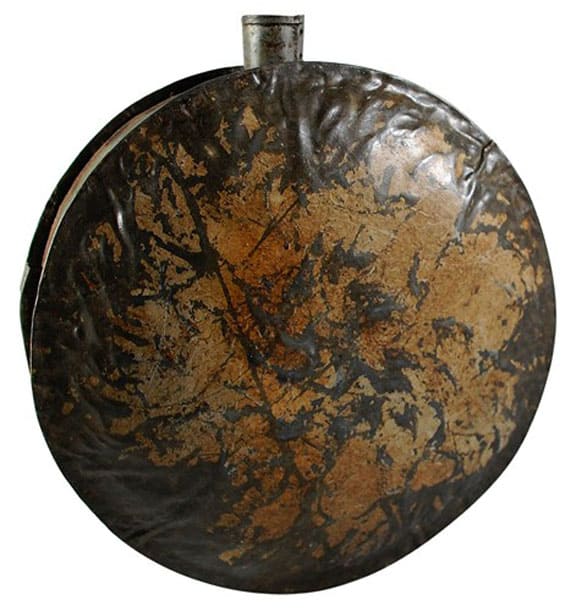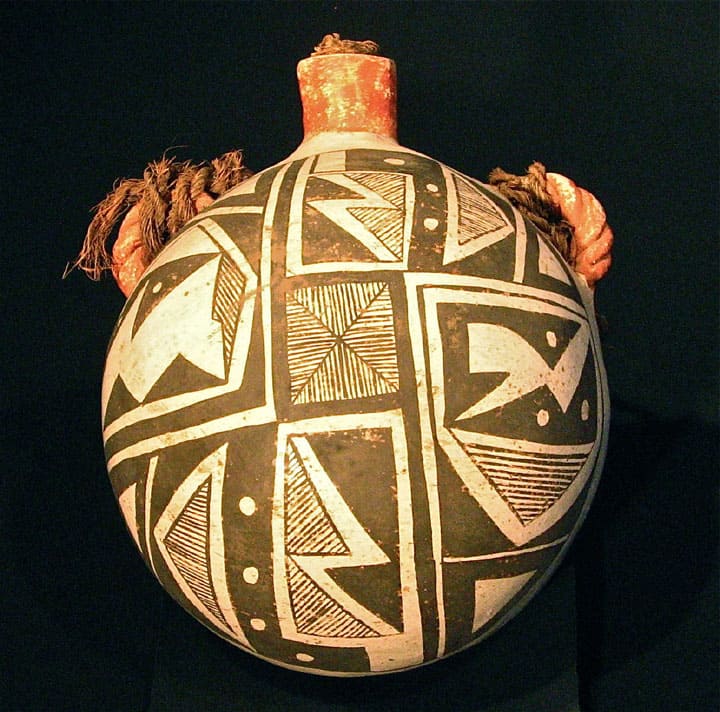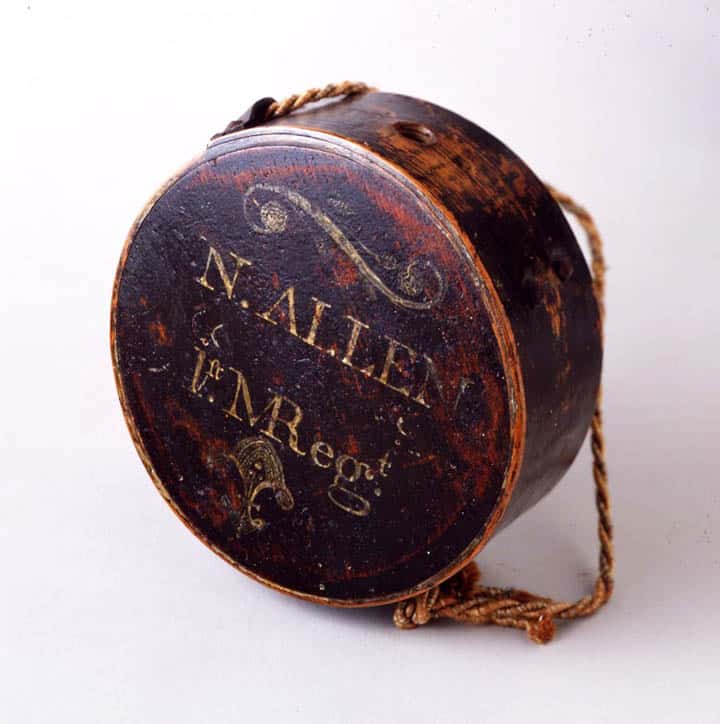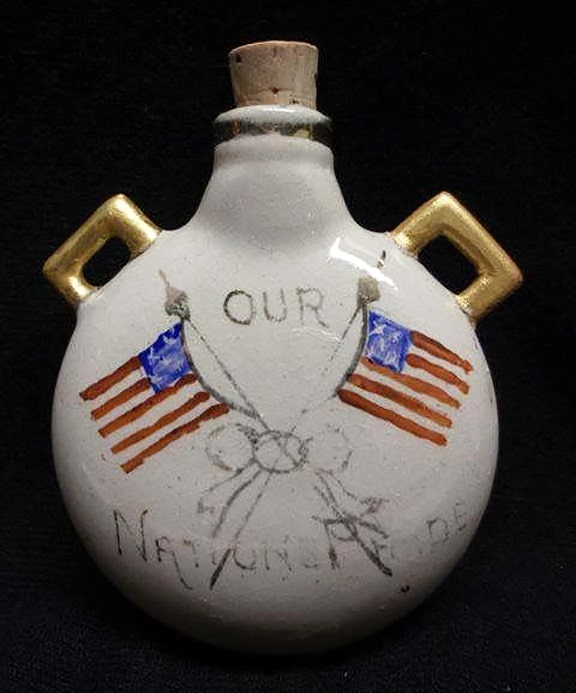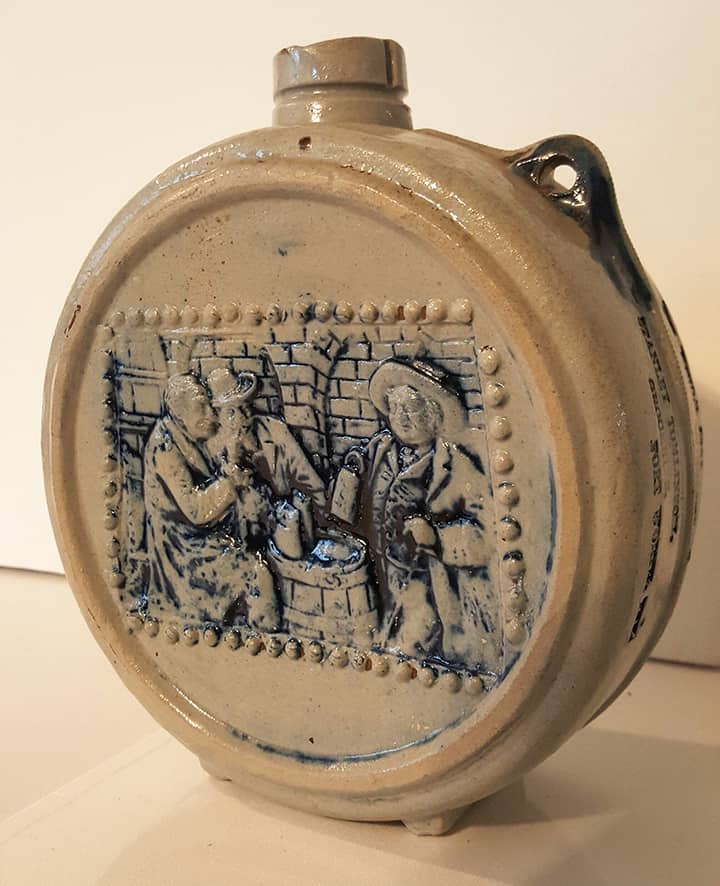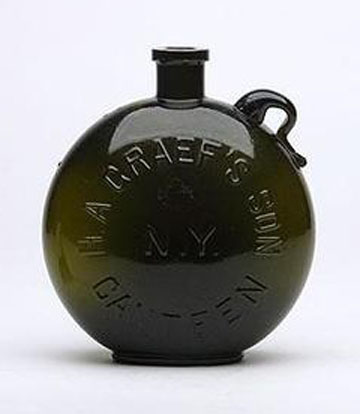
H.A. Graef Canteen – previous Norman C. Heckler Auction
HISTORICAL CANTEENS
Canteen Figural Bottles
19 July 2013 (R•102913) (R•012415) (R•022115) (R•082615)
![]() Jim Hagenbuch has one of the finest H. A. GRAEF’S SON N.Y. CANTEEN bottles I have ever seen at his Glass Works Auction #96 “Cabin Fever” auction that closes this coming Monday night (see image below). A similar example in more of an olive color previously sold with Norman C. Heckler Auctions (image on the top). Notice the difference with the attachment glass pieces and the lip treatment. Great bottles.
Jim Hagenbuch has one of the finest H. A. GRAEF’S SON N.Y. CANTEEN bottles I have ever seen at his Glass Works Auction #96 “Cabin Fever” auction that closes this coming Monday night (see image below). A similar example in more of an olive color previously sold with Norman C. Heckler Auctions (image on the top). Notice the difference with the attachment glass pieces and the lip treatment. Great bottles.
You hardly ever see these Graef bottles. This got me thinking more about canteens in general and wondering who Graef was (another post), were there other Graef examples to look at and what was out there in general with historical canteens.
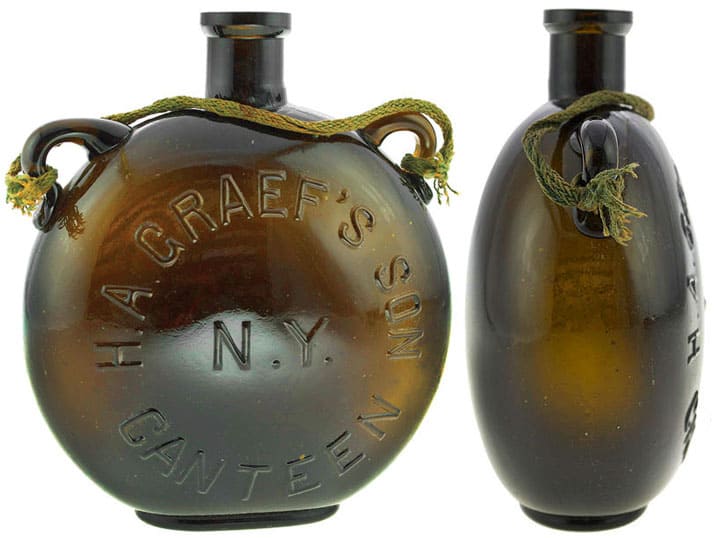
Figural Whiskey Canteen, “H.A. GRAEF’S SON / N.Y. / CANTEEN”, (Denzin GRA-21), New York, ca. 1865 – 1880, deep yellowish olive amber figural canteen, 6 5/8”h, “1200” embossed on smooth base, tooled mouth, applied double handles, period cloth carrying cord. Perfect condition, and in a somewhat different shade of color than normally seen. – Glass Works Auction #96
CANTEEN
canteen (n.) – c. 1710, “store in a military camp,” from French cantine “sutler’s shop” (17c.), from Italian cantina “wine cellar, vault.” Perhaps another of the many meanings, now obsolete, that were attached to Latin canto “corner;” in this case, perhaps “corner for storage.” A Gaulish origin also has been proposed. Extended to “refreshment room at a factory, school, etc.” from 1870. Meaning “small tin for water or liquor, carried by soldiers on the march, campers, etc.” is from 1744, from a sense in French.
THE REALITY
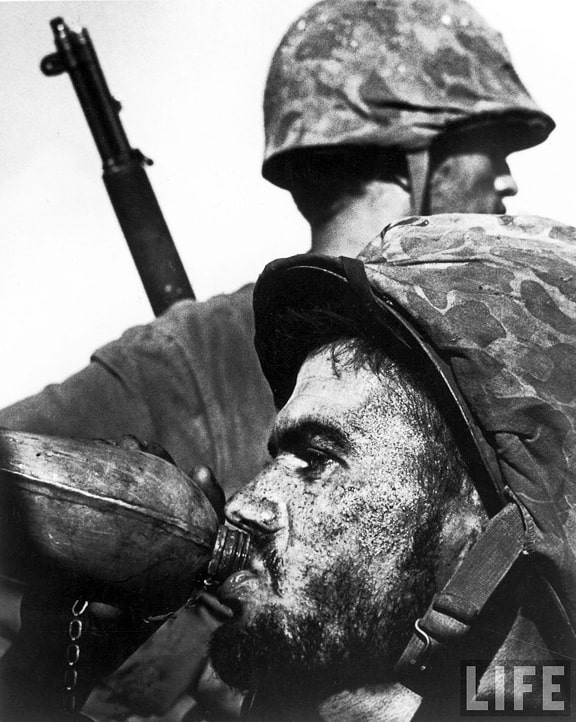
“World War II: Marines, Saipan, Drinking from Canteen” – silver print, ca. 1944 – photographed for Life magazine by Eugene Smith
CANTEEN GALLERY
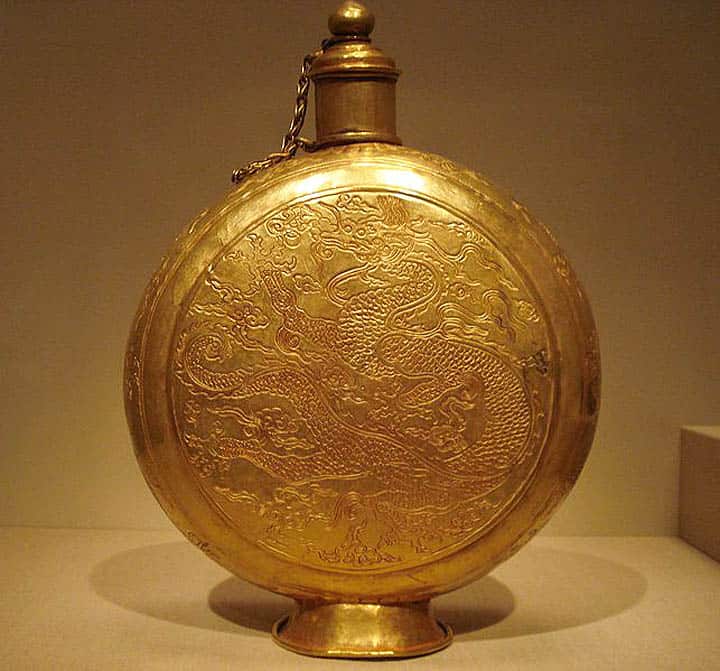
A golden canteen made during the Chinese Ming Dynasty, dated 15th century. – Gold was long held to be a symbol of wealth and prestige in China, and during the Ming Dynasty (1368-1644), the imperial court issued guidelines to partially restrict its use. In theory, only society’s most privileged were allowed to own large amounts of gold vessels and tableware. This canteen, decorated with a five-clawed dragon—a symbol of the emperor—was probably made for members of the ruling house. Based on style, this canteen dates to the fifteenth century. Its technique is repousse (a method of decorating a surface by hammering the reverse of the object). One of the round panels of the canteen’s belly was left open so that most of the vessel could be decorated from the inside. To close the canteen, a separately decorated sheet of gold was soldered in place. – Freer and Sackler Galleries, Washington D.C.
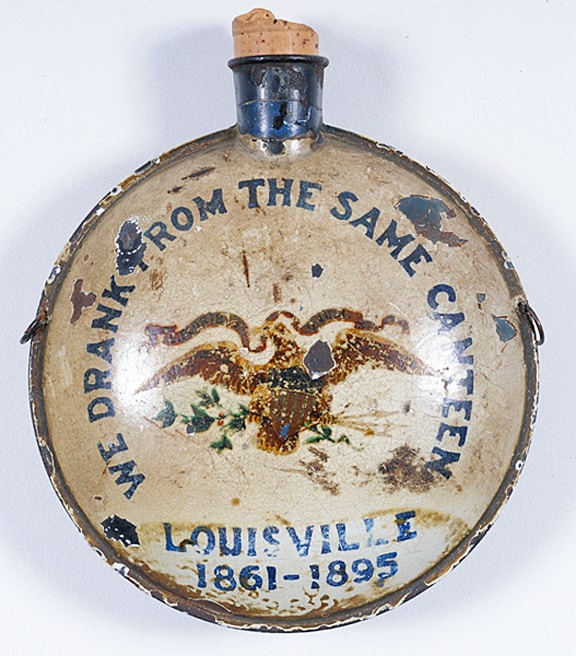
Gar Louisville Canteen – A ca 1895 canteen, tin with original polychrome painted stenciled decoration/inscription We Drank From The Same Canteen arched above a U.S. shield breasted spread winged eagle with E Pluribus Unum ribbon banner in beak, arrows & laurel branches in talons and straight-line inscription Louisville / 1861-1895 at bottom, with two small rings at sides for hanging, 5″ 0 diameter. – Cowan’s Auctions
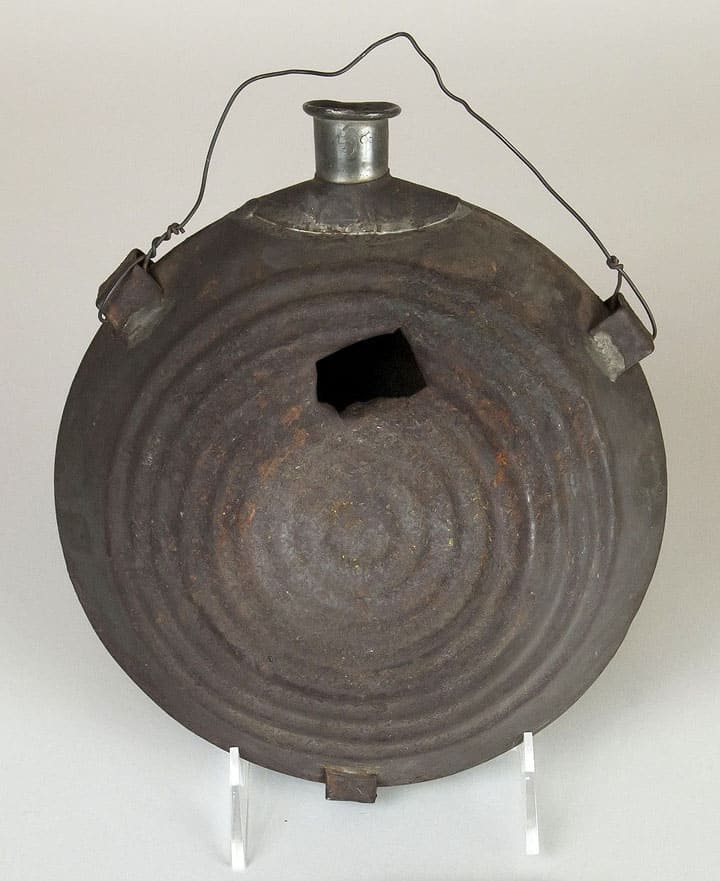
Civil War exhibit – bullet struck canteen from 1862-Courtesy of Stan Freeny – Macculloch Hall Historical Museum (Read Story)
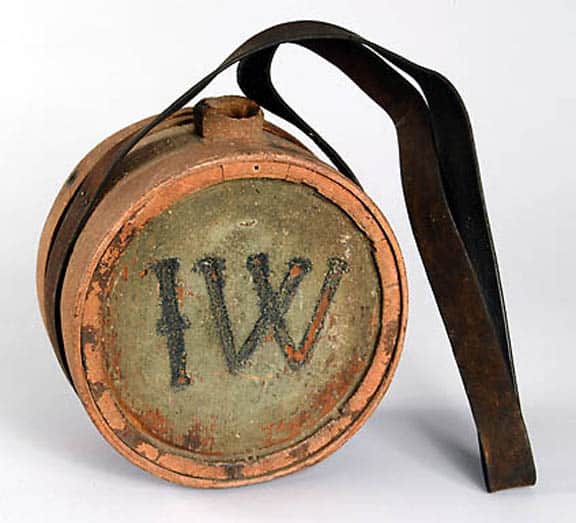
18th Century Canteen “IW” carved on both sides. Carried by Isaac Whitehead during the Revolutionary War. Wood, leather. D 19.7, W 10.8, L (strap) 143.5 cm – Morristown National Historical Park
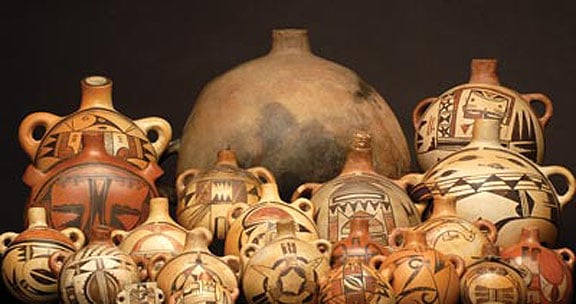
Hopi Canteen Collection – Steve Elmore Indian Art
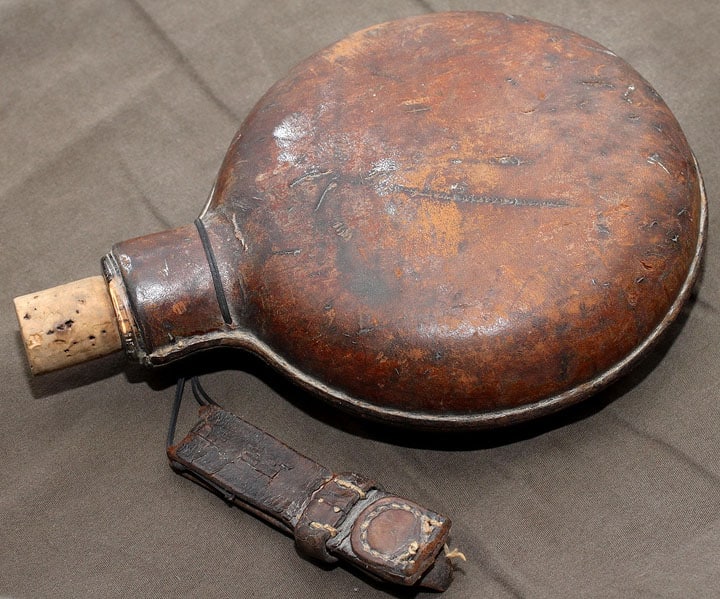
Leather covered glass canteen. Standard issue for the Danish armed forces, 1856 to about 1930. This is the 1873 version, made by Holmegaard Glasværk – Glashistorisk Museum
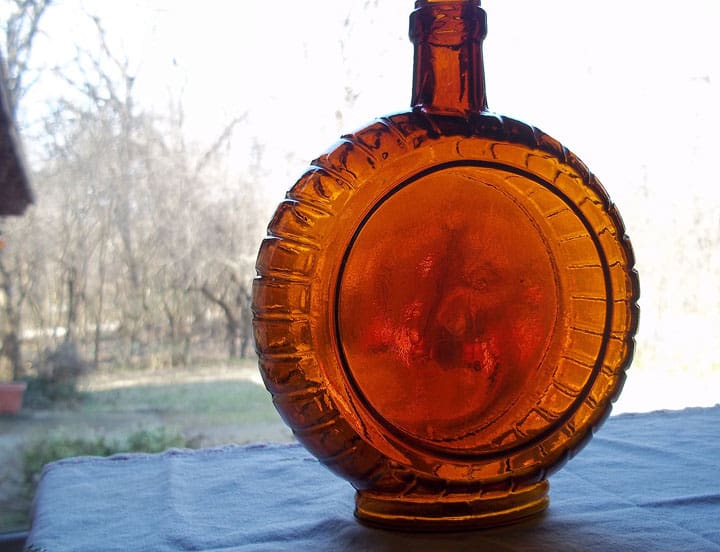
Antique Brown Whiskey Bottle in “canteen” form. Small shield on the bottom. No letters, numbers, etc. It is 8″ tall and 6″ wide. – Etsy
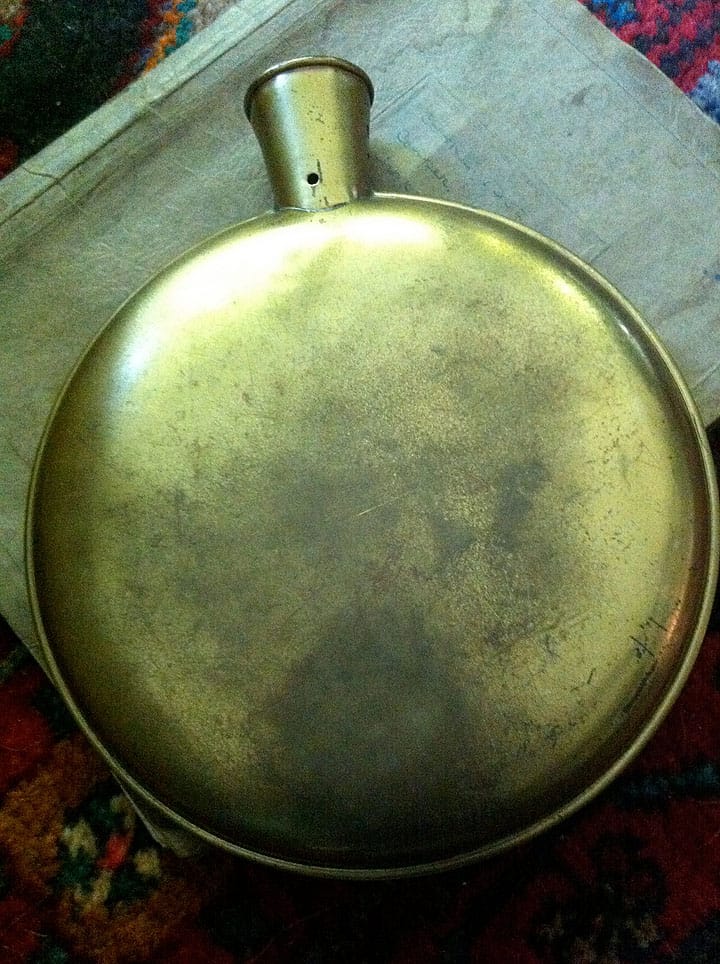
Antique Brass Cello Canteen – Hot Water by A.S. Campbella Emblem: “Guaranteen Five Years. Sanitary Hot Water Bottle CELLO A. S. Campbell Co. Boston Trade Mark. # 9 , Pat. Nov. 26, 1912.” – Etsy
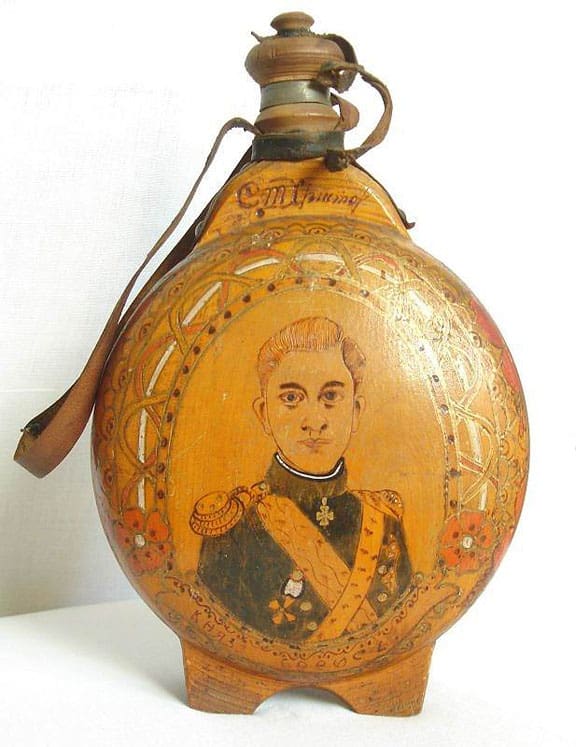
Antique 1912-1914 Kingdom Bulgaria handmade wooden flask. The obverse an image the young prince Boris (His Majesty King Boris III), on the reverse side is the Coat of arms of the Principality of Bulgaria and an inscription dedication- “Of the reserve captain Lazarov from St. P. Kiossev” 1912-1913. The wooden flask bottle has original stopper with hanged leather strap, long leather strap and and very rich decoration. Handmade, hand engraved (pokerwork) and hand painted and coloured. – ebay
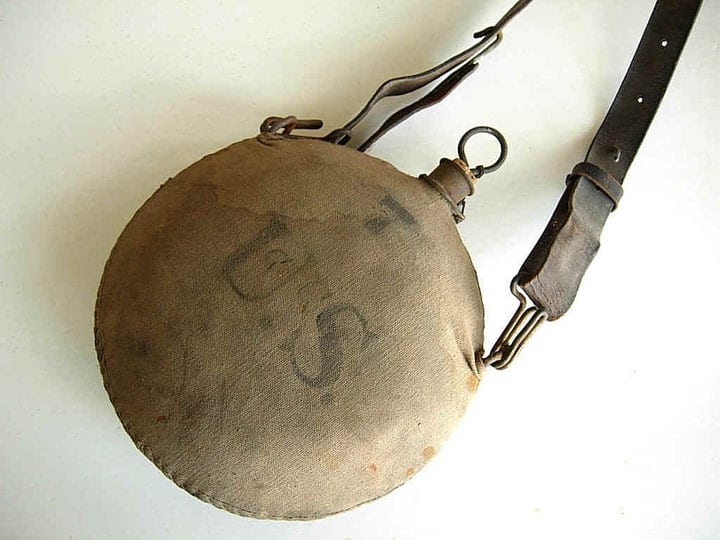
Spanish American War Canteen – Cuba Service – San Juan Hill & El Caney
One side is marked 7th US. The other shows Company F 2nd US Artillery. Both served in Cuba during the Spanish American War. Both fought at El Caney and San Juan Hill. – www.Gatling-Gun.com
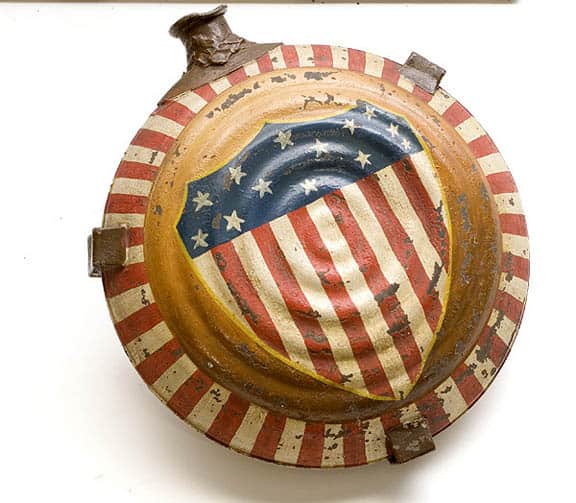
Civil War Bull’s-Eye Canteen with folk art painted U.S. shield, polychrome-painted with U.S. shield on yellow ocher ground with red and white-rayed surround. Canteen is typical Civil War bull’s-eye-type tin with pewter spout and 3 tin bands for strap, 7.5″ diameter, reverse painted white. Likely decorated for GAR encampments. – Cowan’s Auctions
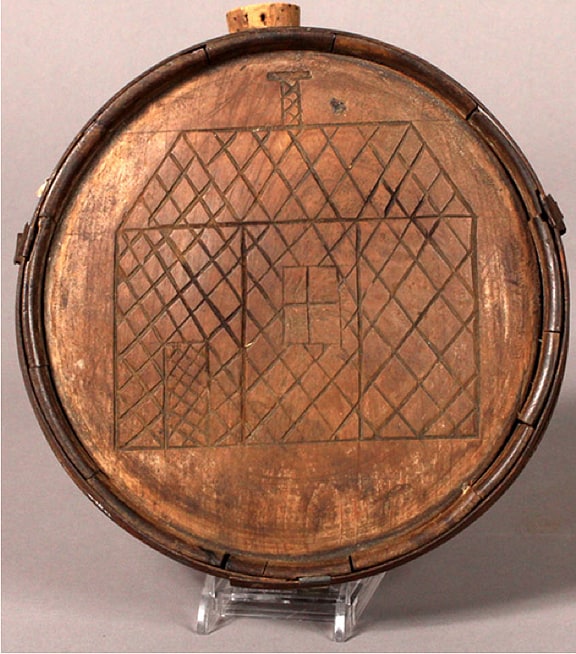
Canteen, 1863 – This round wooden barrel canteen is made of cedar and is held together by two tin straps. On one side is an inscription that reads “W. C. FLETCHER 4TH KY.” A house is carved on the other side of the canteen. Wood was used for the canteen because metal supplies were low in the South by 1862. William C. Fletcher joined the Confederate Army in 1861. He was about 18 years old. He died on May 7, 1865, most likely while fighting at the battle of Dallas, in Georgia. – A State Divided
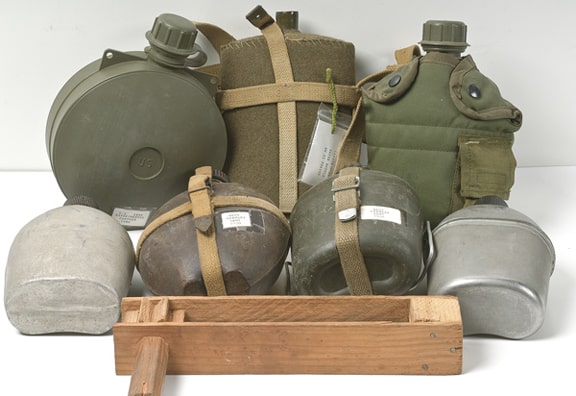
Lot of seven Korean War era canteens. – WWI U.C. canteen; WWII U.S. canteen dated 1943; Canadian Army WWII canteen; U.S. Vietnam plastic canteen with iodine tablets; U.S. Army experimental canteen ca 1980; West German Army canteen ca 1950; and West German Army canteen ca 1956. Plus, WWI battle rattle. – Cowan’s Auctions
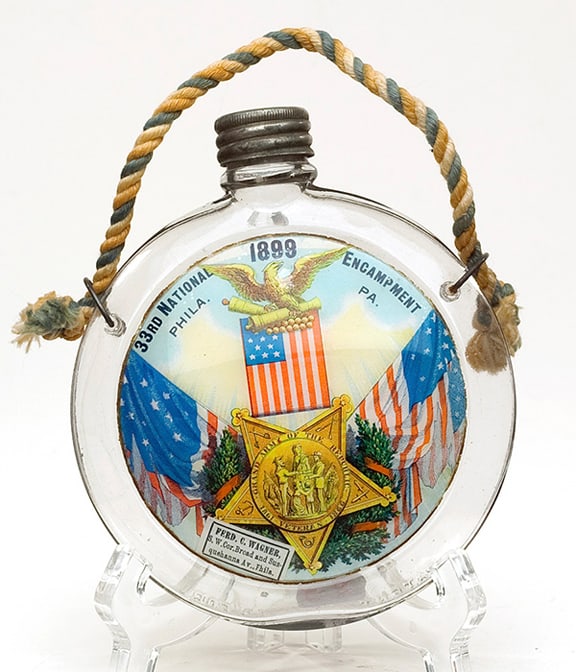
“33rd National 1899 Encampment / Phila. Pa.” Label Under Glass Flask, America, 1899. Colorless, canteen form, threaded ground mouth with original metal closure. Colorful graphics, “Grand Army Of The Republic / 1861 * Veteran * 1866” (within star), wreath and two American flags below an eagle perched above two cannon barrels and a third flag), “Fred C. Wagner / S.W. Cor.Broad and Sus- / quehanna Av., Phila.” (in lower left). “U.S.” debossed on reverse, perfect and rare! – American Glass Gallery Auction 11
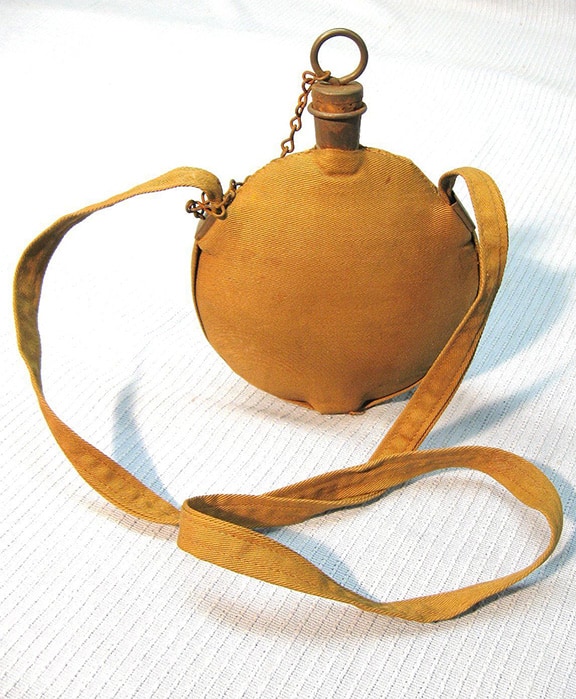
This canteen is 5.5” in diameter with identification on the strap brackets that reads; “JUNIOR HIKE NY”. – Gary Lynch
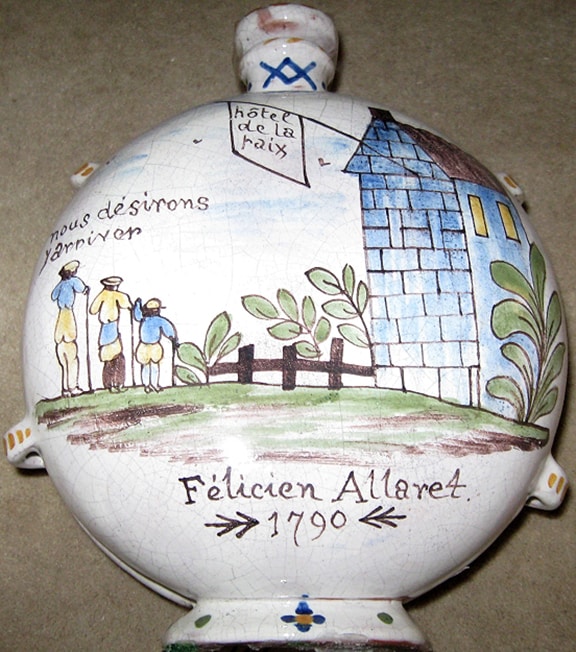
Faience parlante, (French: “talking faience”), in French pottery, popular utilitarian 18th-century earthenware, principally plates, jugs, and bowls, that had inscriptions as part of its decoration. The city of Nevers was the outstanding centre for the production of faience parlante. The range of inscriptions included owners’ names, coats of arms, bacchic or facetious references, Masonic and trade emblems, quotations from songs and proverbs, urban views, allegorical designs, and commemorative themes. – collection Jean T
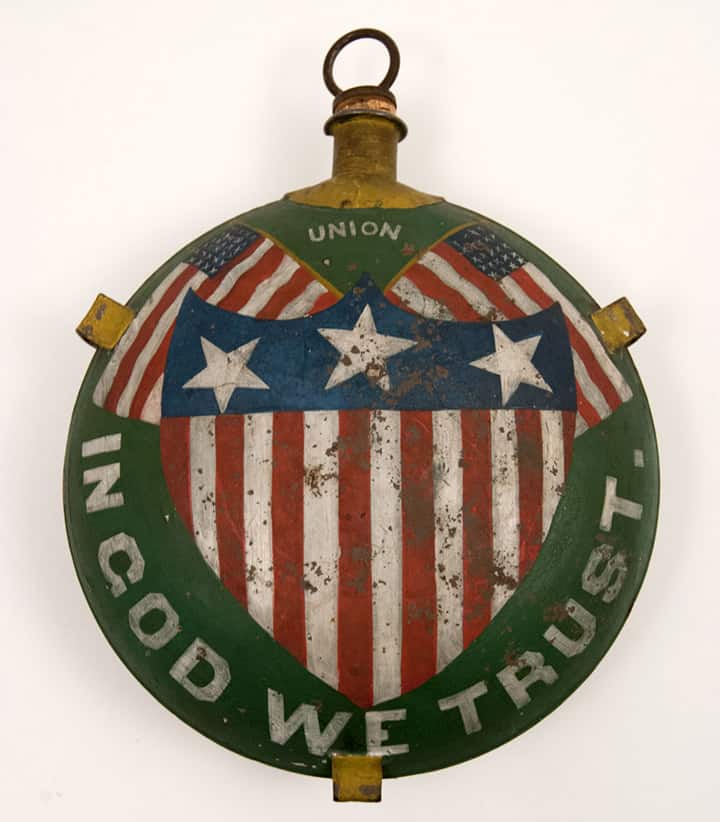
Circa 1876: This Civil War canteen belonged to Charles H. Davis, who served in Company G. of the 12th Massachusetts Volunteers. Obviously, Mr. Davis had his battle canteen painted for GAR reunion encampments, and we believe that this canteen was made for the centennial encampment because of the red, white, and blue American flag and shield and the additions of the words “Union” and “In God We Trust.” This five color painted canteen would have made quite an impression on its viewers and would have showcased Mr. Davis’s love of God and country, values which have become woven into the American fabric. – Z&K Antiques

